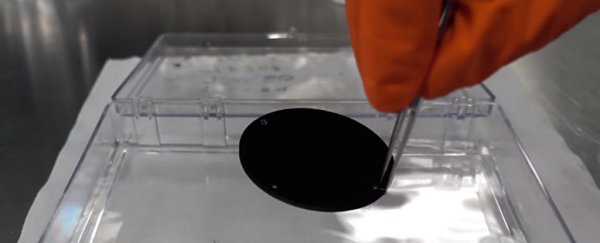One of the very first things you'll learn in science class is that if something is denser than water, it sinks. A rock or a hunk of metal is denser than water, so no surprises what happens when you chuck one of those into a pond, but styrofoam is less dense than water, so it floats. Strangely enough, crude oil is slightly less dense than salt water, so that's why it floats on the surface of the ocean.
Now that we've established the rules, let's break them, using the coolest material ever - Vantablack, the blackest material on Earth.
In the video above, scientists from Surrey Nanosystems - the British company that invented Vantablack back in 2014 - demonstrate how the material is somehow able to make an aluminium disk float in a tub of water.
As you can see in the footage, both the aluminium and the water aren't particularly happy about the situation, because the water is doing everything it can to bulge up and over the aluminium, but the incredibly hydrophobic Vantablack coating keeps repelling it away.
When the aluminium is dunked and retrieved from the water, it's completely dry.
So what the hell is this physics-breaking substance? It might look like it, but Vantablack isn't a paint, pigment, or fabric - it's a special coating made from millions of carbon nanotubes, each one measuring around 20 namometres by 14 to 50 microns (1 nanometre equals 0.001 microns).
According to Surrey Nanosystems, a surface area of just 1 cm squared would contain around 1,000 million of these nanotubes.
When it was first unveiled back in 2014 as the blackest material ever produced, it could absorb all but 0.035 percent of visible light, making it borderline invisible to our eyes. In March, the team managed to make it even more black, and claimed that no spectrometer in the world is powerful enough to measure how much light it absorbs.
The reason Vantablack can render a dense aluminium disk buoyant is because, not only is it incredibly black, it also has ultra-low surface energy. As the video above explains, the coating's low surface energy combined with the area of the disk helps to give it positive buoyancy. So cool.
To see more of this crazy stuff in action, here's the newest iteration of the immeasurably black Vantablack:
H/T: Digg
